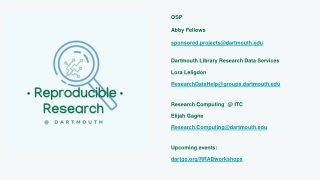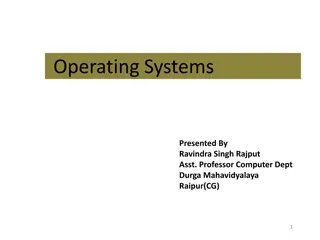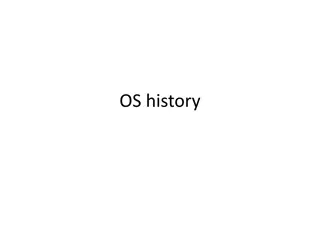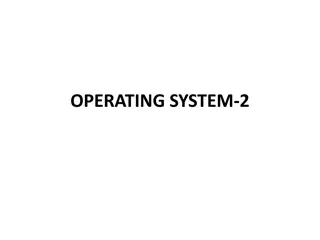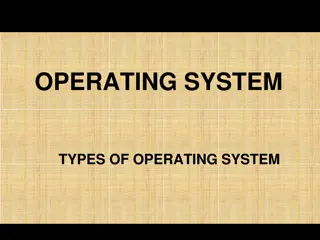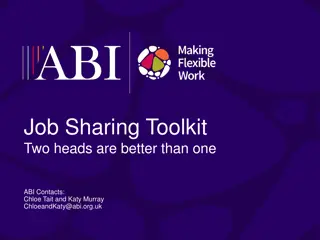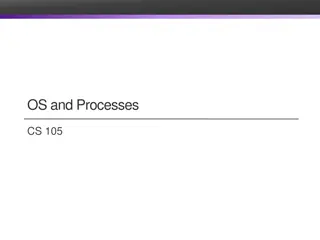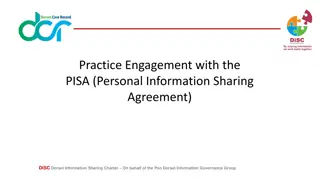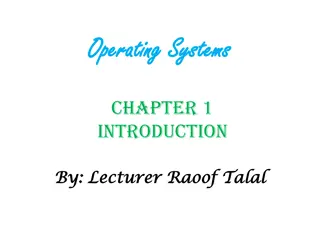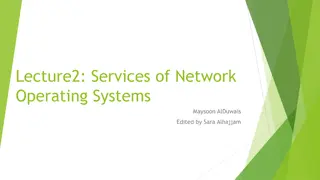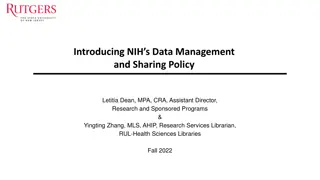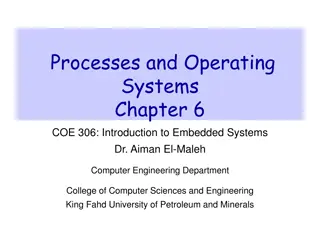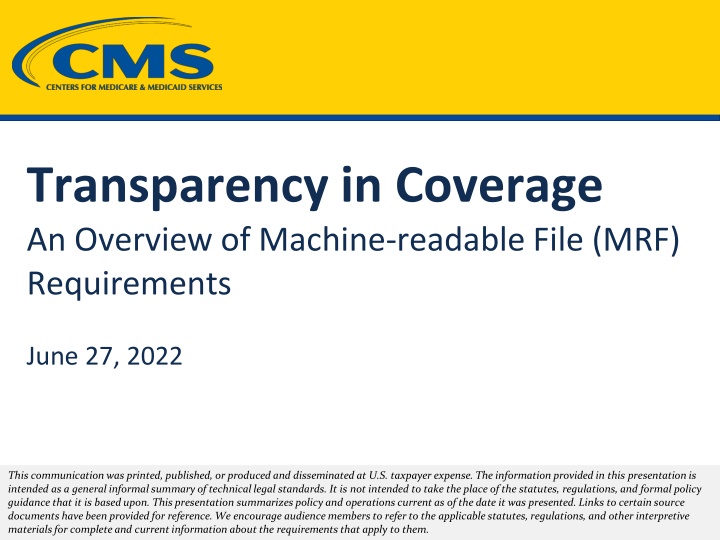
Evolution of Time Sharing Operating Systems
This content traces the evolution of time-sharing operating systems, from the groundbreaking ideas proposed in the 1960s to the development of systems like Multics and UNIX. Time sharing allowed for the efficient allocation of a single resource to multiple users, revolutionizing the way computers are used. Explore the history and significance of these systems in shaping modern computing.
Download Presentation

Please find below an Image/Link to download the presentation.
The content on the website is provided AS IS for your information and personal use only. It may not be sold, licensed, or shared on other websites without obtaining consent from the author. If you encounter any issues during the download, it is possible that the publisher has removed the file from their server.
You are allowed to download the files provided on this website for personal or commercial use, subject to the condition that they are used lawfully. All files are the property of their respective owners.
The content on the website is provided AS IS for your information and personal use only. It may not be sold, licensed, or shared on other websites without obtaining consent from the author.
E N D
Presentation Transcript
Transparency in Coverage An Overview of Machine-readable File (MRF) Requirements June 27, 2022 This communication was printed, published, or produced and disseminated at U.S. taxpayer expense. The information provided in this presentation is intended as a general informal summary of technical legal standards. It is not intended to take the place of the statutes, regulations, and formal policy guidance that it is based upon. This presentation summarizes policy and operations current as of the date it was presented. Links to certain source documents have been provided for reference. We encourage audience members to refer to the applicable statutes, regulations, and other interpretive materials for complete and current information about the requirements that apply to them. 1
Objective To provide state regulators with an overview of the: Transparency in Coverage (TiC) Final Rule o Machine-Readable File (MRF) Requirements o Internet-based Price Comparison Tool Requirements Resources available ahead of the July 1, 2022 MRF requirement implementation date 2
Background The TiC final rules finalized by the Departments of Health and Human Services, Labor, and the Treasury (the Departments) appeared in the November 12, 2020 edition of the Federal Register. (85 FR 72158) The TiC final rules require most group health plans and issuers in the group or individual market to disclose pricing information. The TiC Rules implement legislative mandates under sections 1311(e)(3) of Patient Protection and Affordable Care Act (ACA) and section 2715A of the Public Health Service (PHS) Act. 3
TiC Requirements For plan/policy years beginning on or after January 1, 2022, most group health plans and issuers in the group or individual market would have been required to post information about costs related to covered items and services in a machine-readable format on a barrier-free, publicly available website (stage 1). However, in August 2021, the Departments released FAQs 49 that: 1. stated that the Departments would exercise enforcement discretion, deferring enforcement of the prescription drug pricing MRF requirement pending further rulemaking and the other MRF requirements until July 1, 2022; and 2. encouraged states with enforcement authority to take the same approach. These MRFs are intended to be analyzed by third parties, such as researchers and app developers, to conduct research and develop products to help consumers better understand the costs associated with their health care and evaluate their health care coverage options. For plan/policy years beginning on or after January 1, 2023 (stage 2) and January 1, 2024 (stage 3), most group health plans and issuers in the group or individual market must make available cost-sharing information for covered items and services to participants, beneficiaries, or enrollees through an internet-based self-service tool (or in paper form, upon request). 4
Three Stages of Implementation STAGE1 Three Separate MRFs, one each for in-network provider rates, out-of- network allowed amounts and billed charges, and negotiated rates and historical net prices for prescription drugs.* Internet-based price comparison tool (or disclosure on paper, upon request) allowing an individual to receive an estimate of their cost-sharing responsibility for a specific item or service from a specific provider or providers, for at least 500 items and services identified by the Departments. STAGE2 Internet-based price comparison tool (or disclosure on paper, upon request) allowing an individual to receive an estimate of their cost-sharing responsibility for a specific item or service from a specific provider or providers, for all covered items and services. STAGE3 5 * Enforcement of the prescription drug MRF requirement has been deferred pending further rulemaking.
TiC Implementation Timeline The Departments begin enforcement of In-Network Rate File and Out-of-Network Allowed Amount File requirements* Internet-Based Price- Comparison Tool for 500 Items and Services requirement takes effect. Internet-Based Price- Comparison Tool for ALL Items and Services requirement takes effect. TiC final rules finalized by the Departments appear in the Federal Register. Technical Guidance Issued on GitHub** STAGE1 STAGE3 STAGE2 November 12, 2020 July 1, 2022 January 1, 2023 January 1, 2024 *Enforcement of the prescription drug MRF requirement has been deferred pending further rulemaking. **GitHub technical guidance will remain available post July 1, 2022. 6
Who MUST COMPLY? Health Insurance Issuers Offering Non-Grandfathered Coverage in the Group and Individual Markets (including through the Exchanges) Non-Grandfathered Group Health Plans Grandmothered Plans 7
Plans that DO NOT need to meet TiC Requirements Short-term Limited-Duration Plans Grandfathered Plans Excepted Benefits Medicaid, including Medicaid Managed Care Organization plans Medicare, including Medicare Advantage Retiree Only Plans Health Reimbursement Arrangements (HRAs), including ICHRAs and QSEHRAs Flexible Spending Accounts (FSA) Health Savings Accounts (HSA) 8
STAGE1 Machine-Readable Files Starting July 1, 2022, the Departments will begin enforcement of the requirement for non-grandfathered health plans and health insurance issuers offering non-grandfathered coverage in the group and individual markets to make the following two MRFs* available on an internet website, without barriers to access: Out-of-Network Allowed Amount MRF In-Network Rate MRF Allowed amounts and billed charges with respect to covered items and services furnished by out-of-network providers. Rates for all covered items and services furnished by in-network providers. 9 * Enforcement of the prescription drug MRF requirement has been deferred pending further rulemaking.
Common Data Elements in Both In-Network Rate and Out-of-Network Allowed Amount MRFs* STAGE1 Identification of Providers & Place of Service General Information Name of Reporting Entity Type of Entity Date of Last File Update Individual Provider Identifier (National Provider Identifier (NPI) Type 1) Provider Group Identifier (NPI Type 2) Tax Identification Number (TIN) Place of Service Code Identification of Items and Services Identification of Plan or Coverage Plan or Coverage Name Plan Identifier Type of Plan Identifier Type of Plan Market Billing Code Type of Billing Code Billing Code Type Version Covered Items and Services Plain Language Description 10 * OMB Control Number 0938-1372 (CMS-10715, Transparency in Coverage Appendix). Accessed at: https://www.cms.gov/regulations-and-guidancelegislationpaperworkreductionactof1995pra-listing/cms-10715
Data Elements Specific to Each MRF* STAGE1 In-Network Rate MRF Out-of-Network Allowed Amount MRF For Each Covered Item and Service, Applicable In-Network Rates** Out-of-Network Allowed Amounts and Historical Billed Chargesduring the 90-day time period that begins 180 days prior to the publication date of the MRF Negotiation Arrangement (fee-for-service, bundle, capitation) Bundled Codes (if applicable) Covered Services (if capitation and applicable) Negotiated Type (negotiated, derived, fee schedule, percentage, per diem) Negotiated Rate (dollar or percentage amount) Negotiated Expiration Date Unique Out-of- Network Allowed Amount Billed Charge Identification of Items and Services **Elements defined in technical implementation guidance on GitHub available at https://github.com/CMSgov/price-transparency- guide/tree/master/schemas/in-network-rates Payment Arrangement Indicator 11 *OMB Control Number 0938-1372 (CMS-10715, Transparency in Coverage Appendix). Accessed at: https://www.cms.gov/regulations-and-guidancelegislationpaperworkreductionactof1995pra-listing/cms-10715
STAGE1 Data Requirement Approach The preamble to the final rules indicates that the requirements for the machine-readable file(s) will be sufficiently defined and standardized under the Departments technical implementation guidance. This technical implementation guidance will be available for each of the three machine-readable files through GitHub. * Complex, voluminous collection of previously hidden information Difficult to establish format for every necessary data element beforehand GitHub useful tool for ongoing collaboration during implementation Necessary to add/modify data elements post-PRA based on discussions with plans and issuers *OMB Control Number 0938-1372 (CMS-10715, Transparency in Coverage Supporting Statement). Accessed at: https://www.cms.gov/regulations-and-guidancelegislationpaperworkreductionactof1995pra-listing/cms-10715 12
MRF Schema Technical Implementation STAGE1 CMS uses GitHub an online collaborative hosting platform for development and source code management to host the technical implementation guidelines and TiC file Schema Version 1.0. Facilitates a collaborative environment between the Departments and plans and issuers . Enables the Departments to update the file technical requirements to keep pace with and respond to technological developments. 13
Machine Readable File Format, Display, and Accessibility STAGE1 The MRFs posted by plans and issuers must adhere to specific format, display, and accessibility requirements: o Compliant with accepted file formats (non-proprietary, open format) Examples of accepted formats: JSON, XML, CSV Examples of non-accepted formats: PDF, XLS/XLSX o Publicly available without restrictions No required log-in, credentials, or personal information Hosted on either the plan s website or a third-party s website o URLs must use HTTPS for security o Updated monthly 14
What is the TiC MRF File Schema? STAGE1 The MRFs posted by plans and issuers must comply with a required file schema as established by CMS. A schema is a formal set of technical layout rules. o A schema describes how the contents of a file (i.e., the data) are to be displayed. o There are many ways to represent or report data. A schema ensures that the data representation is consistent. CMS has developed the schemas for the required MRFs with active input from the community on GitHub. 15
What is the TiC MRF File Schema? STAGE1 The TiC File Schema requirements were finalized on March 1, 2022 in Version 1.0. Iteration will continue as new improvements are made (V 1.1, 1.2, etc.), but compliance with the final rules will be assessed against Version 1.0.* *Compliance will be assessed against Version 1.0 but may be assessed against updated versions in the future. The Departments will issue guidance indicating a change to standards sufficiently in advance for plans and issuers, as well as states, to comply with updated schema requirements. 16
Example of Schema Documentation STAGE1 Below is a snapshot of the documentation on GitHub that defines each attribute required by the schema. Shepaysthebinderpaymentfullyorwithinthe tolerance of an applicable premium payment threshold by the deadline of January 1, 2020. https://github.com/CMSgov/price-transparency-guide/tree/master/schemas/in-network-rates 17
STAGE1 What is a Schema Attribute? Here is an example of a schema attribute describing the rules for reporting the "Taxpayer Identification Number (TIN). Schema Definition Machine Readable Reporting Shepaysthebinderpaymentfullyorwithinthe tolerance of an applicable premium payment threshold by the deadline of January 1, 2020. Full schema definitions can be found on the GitHub site: https://github.com/CMSgov/price-transparency- guide/tree/master/schemas 18
STAGE1 How do you view an MRF? Below are potential tools to handle large data sets that regulators could leverage to open and analyze the MRFs. Text Editors (dependent on the computer's resources) Sublime Vim Notepad Databases Cassandra Base MongoDB Apache Hadoop File Systems Cloud Environments to Handle Files and Processes Languages Amazon (AWS) Microsoft (Azure) Python R Java/Scala 19
STAGE1 Validator Tool CMS developed a downloadable program that plans, issuers, and developers can use to assess whether their MRFs are compliant with the TiC JSON schema. The tool can be used to validate all the MRFs in JSON. This tool does not validate the accuracy of the data itself, just that it is expressed in the proper format. The tool is also available on CMS GitHub. 20
STAGE1 Things to Look for Two (2) MRFs posted online In-network Rate and Allowed Amount files The website where the files are posted must be public and accessible without special credentials or logins/passwords Website must use HTTPS File format must be compatible a non-proprietary, open- standards format that is platform independent (e.g., JSON, XML) A validator tool is available for use on JSON files. A pass validates the format of the data, not the accuracy of the data itself Files must be updated monthly (approximately every 30 days ) Opening the files to review the data elements may require a specific type of computer/capabilities 21
Internet-Based Price Comparison Tool STAGE 2/3 Tool will provide estimates of consumers cost-sharing responsibility for a specific item or service from a specific provider o For 500 items and services for plan/policy years beginning on or afterJanuary 1, 2023. o For all covered items and services for plan/policy years beginning on or after January 1, 2024. 22
Internet-Based Price Comparison Tool Requirements STAGE 2/3 The internet-based price comparison tools must: o Permit members to search cost-sharing information for specific health care items and services based on billing code or description. o Allow members to compare costs across both in-network and out-of-network providers. o Inform members of the individual s status related to plan or policy accumulators to date (e.g., deductibles, out-of-pocket maximum, visit limits, etc.). o Allow members to search by factors that impact cost, such as service location, facility name, or drug dosage. o As an alternative, plans and issuers must provide cost estimates in paper format at the member s request. 23
Resources CMS Price Transparency Website o Overview of Transparency in Coverage Requirements for Plans and Issuers o Links to FAQ and GitHub o Technical Clarifications o Webform for submitting help requests and inquiries o Archived webinars o List of 500 items and services for Tool CMS TiC GitHub Site and Final Schema o Schema Validator Tool Regulations and Guidance o TiC Final Rules o TiC PRA Package o Affordable Care Act FAQs #49 and #53 24
What Should NAIC Members Know? Enforcement of MRF files requirement beginning 7/1/22 o Updated monthly thereafter Price Estimator Tool: o Required 1/1/23 for 500 items and services o Required 1/1/24 for all items and services 25
Questions? 26

